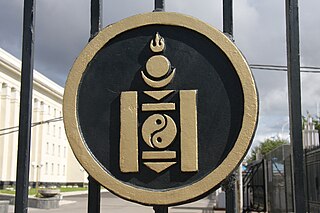
The swastika is an ancient religious and cultural symbol, predominantly found in various Eurasian cultures, as well as some African and American ones. In the western world it is more widely recognized as a symbol of the German Nazi Party who appropriated it from Asian cultures starting in the early 20th century. The appropriation continues with its use by neo-Nazis around the world. The swastika never stopped being used as a symbol of divinity and spirituality in Indian religions, including Hinduism, Buddhism, and Jainism. It generally takes the form of a cross, the arms of which are of equal length and perpendicular to the adjacent arms, each bent midway at a right angle.

Horus, also known as Heru, Har, Her, or Hor in Ancient Egyptian, is one of the most significant ancient Egyptian deities who served many functions, most notably as the god of kingship, healing, protection, the sun, and the sky. He was worshipped from at least the late prehistoric Egypt until the Ptolemaic Kingdom and Roman Egypt. Different forms of Horus are recorded in history, and these are treated as distinct gods by Egyptologists. These various forms may be different manifestations of the same multi-layered deity in which certain attributes or syncretic relationships are emphasized, not necessarily in opposition but complementary to one another, consistent with how the Ancient Egyptians viewed the multiple facets of reality. He was most often depicted as a falcon, most likely a lanner falcon or peregrine falcon, or as a man with a falcon head.

The national flag of Japan is a rectangular white banner bearing a crimson-red circle at its center. This flag is officially called the Nisshōki, but is more commonly known in Japan as the Hinomaru. It embodies the country's sobriquet: the Land of the Rising Sun.

The national flag of the Philippines is a horizontal bicolor flag with equal bands of royal blue and crimson red, with a white, equilateral triangle at the hoist. In the center of the triangle is a golden-yellow sun with eight primary rays, to represent the original eight provinces that rebelled against the Spanish during the 1896 Philippine Revolution. At each vertex of the triangle is a five-pointed, golden-yellow star, each of which representing one of the country's three main island groups—Luzon, Visayas, and Mindanao. The white triangle at the hoist represents liberty, equality, and fraternity. A unique feature of this flag is its usage to indicate a state of war if it is displayed with the red side on top, which is effectively achieved by flipping the flag upside-down.

A solar symbol is a symbol representing the Sun. Common solar symbols include circles, crosses, and spirals. In religious iconography, personifications of the Sun or solar attributes are often indicated by means of a halo or a radiate crown.

A sun cross, solar cross, or wheel cross is a solar symbol consisting of an equilateral cross inside a circle.

The Ashoka Chakra is an Indian symbol which is a depiction of the Dharmachakra. It is called so because it appears on a number of edicts of Ashoka, most prominent among which is the Lion Capital of Ashoka. The most visible use of the Ashoka Chakra today is at the centre of the Flag of India, where it is rendered in a navy blue colour on a white background, replacing the symbol of charkha of the pre-independence versions of the flag. It is also shown in the Ashoka Chakra medal, which is the highest award for gallantry in peacetime.
Fascist symbolism is the use of certain images and symbols which are designed to represent aspects of fascism. These include national symbols of historical importance, goals, and political policies. The best-known are the fasces, which was the original symbol of fascism, and the swastika of Nazism.

The Black Sun is a type of sun wheel symbol originating in Nazi Germany and later employed by neo-Nazis and other far-right individuals and groups. The symbol's design consists of twelve radial sig runes, similar to the symbols employed by the SS in their logo. It first appeared in Nazi Germany as a design element in a castle at Wewelsburg remodeled and expanded by the head of the SS, Heinrich Himmler, which he intended to be a center for the SS.

Cancer (♋︎) is the fourth astrological sign in the zodiac, originating from the constellation of Cancer. It spans from 90° to 120° celestial longitude. Under the tropical zodiac, the Sun transits this area between approximately June 22 and July 22.

Scorpio (♏︎) is the eighth astrological sign in the zodiac, originating from the constellation of Scorpius. It spans 210–240° ecliptic longitude. Under the tropical zodiac, the Sun transits this sign on average from October 23 to November 21. Depending on which zodiac system one uses, someone born under the influence of Scorpio may be called a Scorpio or a Scorpionic.

The 20th-century German Nazi Party made extensive use of graphic symbols, especially the swastika, notably in the form of the swastika flag, which became the co-national flag of Nazi Germany in 1933, and the sole national flag in 1935. A very similar flag had represented the Party beginning in 1920.

The dharmachakra or wheel of dharma is a widespread symbol used in Buddhism. The symbol also finds usage in Hinduism, particularly in places that underwent religious transformation, and in Jainism and in modern India.
Historically, astrological and astronomical symbols have overlapped. Frequently used symbols include signs of the zodiac and classical planets. These originate from medieval Byzantine codices. Their current form is a product of the European Renaissance. Other symbols for astrological aspects are used in various astrological traditions.
A planet symbol or planetary symbol is a graphical symbol used in astrology and astronomy to represent a classical planet or one of the modern planets. The symbols were also used in alchemy to represent the metals associated with the planets, and in calendars for their associated days. Most of the symbols originated in Greco-Roman astronomy; their modern forms developed in the 16th century.

The Soyombosymbol is a special character in the Soyombo alphabet invented by Zanabazar in 1686. The name "Soyombo" is derived from Sanskrit svayambhu "self-created". It serves as a national symbol of Mongolia, to be found on the Flag of Mongolia, the Emblem of Mongolia, and on many other official documents.

The Praja Rajyam Party was a political party in India.

The Vergina Sun, also known as the Star of Vergina, Vergina Star or Argead Star, is a rayed solar symbol first appearing in ancient Greek art of the period between the 6th and 2nd centuries BC. The Vergina Sun proper has sixteen triangular rays, while comparable symbols of the same period variously have sixteen, twelve, eight or (rarely) six rays.

The Hittite Sun Disc Monument is a memorial dedicated to Hittites created by sculptor Nusret Suman and placed in Sıhhiye Square, Ankara, Turkey, in 1978.
















